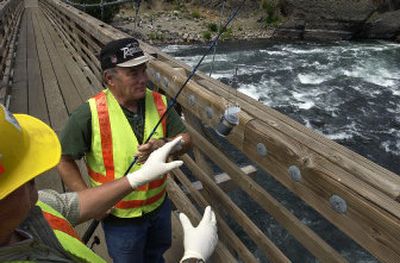Size of sewage spill unknown

City crews scrambled on Wednesday to adjust a monitoring system that allowed raw sewage to spill undetected into the Spokane River, possibly for days or weeks.
Engineers and other officials were considering whether to remove a piece of faulty pipe or whether to move or add sensors designed to warn when overflows occur, said Dave Mandyke, acting director of Spokane Public Works and Utilities.
“We don’t believe the sensor failed,” said Mandyke. “We had a backup farther down the line that didn’t trigger the sensor.”
A fisherman on Tuesday noticed sewage spewing from the city pipe near Kiernan Avenue and Northwest Boulevard. The combined sewer outflow is one of 27 sites monitored with electronic equipment designed to measure volume and flow. Twenty-one of those monitors are displayed on a city Web site, www.spokanewastewater.org
But the sensor on the affected site, CSO 6, was located above where a partially blocked pipe diverted sewage headed for the treatment plant. The overflow spilled into an eroded pipe, which gave way and sent sewage through the outflow and into the river, Mandyke said.
The sensors, which cost several thousand dollars apiece, typically are placed where engineers believe they’ll best detect overflows, he said. That’s not necessarily at the mouth of the pipe.
“It’s not that simple a situation,” Mandyke said. “At first blush, I thought so, too.”
No one knows how much sewage discharged into the river. City officials have five days to submit a required report to the Washington Department of Ecology, and Mandyke said an estimate could be available then.
Nearly a dozen similar incidents occurred in 2005, when nearly 140,000 gallons of raw sewage spilled illegally into the river during dry weather, city records showed. That included a single incident on Sept. 21, when nearly 65,000 gallons of sewage gushed into the river in about an hour from an outflow at Columbia Circle and Downriver Drive.
Most sewage discharges are legal because they happen during rainstorms that overwhelm the city’s wastewater treatment plant. In 2004, 63.8 million gallons of mixed sewage and storm water entered the river during 278 incidents. In 2005, 58.4 million gallons were discharged in 306 incidents, city records showed.
The amount released during the most recent event depends on how long the blocked line went unnoticed. The fisherman who reported the spill, Michael Pickering, said he first noticed a needle in the river a month ago.
But a woman who lives downriver, at Suncrest Park, just past Nine Mile, said Wednesday that she noticed debris even sooner.
“As early as May, I found syringes on the beach,” said Michele Nelson, the park’s caretaker. “There were lots of tampon dispensers and condoms. There’s just been an unusual amount of garbage and gross stuff.”
Mandyke said he didn’t think the spill could have been going on since May, but he couldn’t rule it out. He said discharges are inevitable in a system that includes 1,200 miles of pipe, including some 400 miles of combined sewers – pipes that carry sewage and storm water, both. It’s all part of a system that treats between 35 million and 40 million gallons of wastewater every day.
“You’re going to have things happen, and you want to be sure it doesn’t happen again,” he said. “The city of Spokane is the best steward of the river.”
In part, that’s because state and federal mandates have forced the city to reduce river discharges. A $50 million upgrade in the 1980s eliminated more than 85 percent of the volume of sewage-tainted overflows. But by 2017, Spokane must have no more than one overflow for each of its 27 river outlets a year, according to Ecology officials.
In the meantime, residents are calling for closer monitoring of sewage that can boost levels of bacteria to unhealthy, even dangerous, levels.
“I think it’s terrible,” said Nelson. “There are so many people on this river and this lake. We’ve been swimming. It’s really scary.”
A two-man crew from the city’s wastewater laboratory collected a water sample Wednesday afternoon from the hanging bridge near the Bowl and Pitcher campground in Riverside State Park, less than a mile from the plant, and at the Seven Mile Bridge.
The crew planned to collect samples from five sites to test for fecal bacteria, with results expected in 24 hours. Levels typically spike after an overflow and then decrease over a few days, said lab supervisor Mike Cannon.
Yellow signs stapled to trees near the campground warned visitors to stay out of the water. Camp hosts Dan and Sue Cole learned of the sewage leak Tuesday while watching television in their trailer, and they informed Park Ranger Rob Kennedy.
Kennedy said few people swim in the area because of dangerous whitewater, and he usually sends would-be swimmers to a calmer area downstream. But he said kayakers and rafters often float past the campground. He kayaked the river Monday, from the TJ Meenach Bridge past the campground, and didn’t see or smell sewage, he said. Learning about it didn’t bother him too much, he said. “They allow so much raw sewage to go in the first place,” he added.
The Coles, who have hosted the camp for 14 years, said that some people don’t heed the warning signs. But camper John Svenn, an engineer from Spokane, wasn’t fishing Wednesday.
“It’s a shame that they had to build a sewage plant right here on the river,” he said. “There’s got to be a better way.”